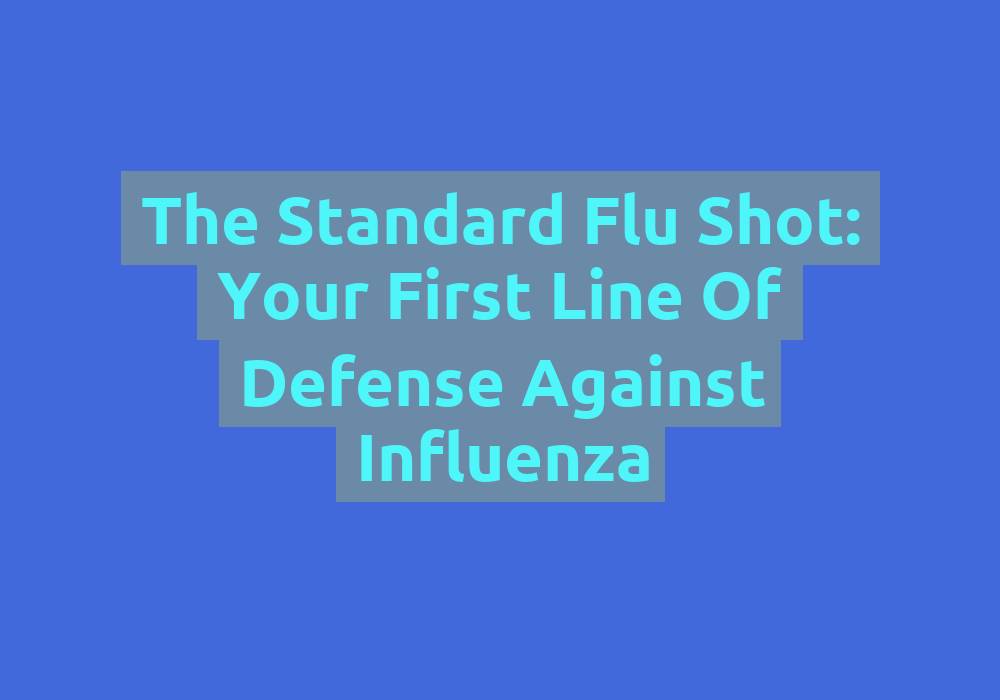The Standard Flu Shot: Your First Line of Defense Against Influenza

Influenza, commonly known as the flu, is a contagious respiratory illness caused by influenza viruses. It can cause mild to severe illness and even lead to hospitalization or death in severe cases. Each year, millions of people around the world are affected by the flu, making it a significant public health concern.
One of the most effective ways to prevent the flu is by getting a flu shot. The standard flu shot is a vaccine that helps your body develop immunity to the influenza virus. It is recommended for everyone above the age of six months, especially those at high risk of complications from the flu, including young children, pregnant women, older adults, and individuals with chronic health conditions.
How Does the Flu Shot Work?
The flu shot works by introducing inactivated influenza viruses into your body. These viruses cannot cause the flu. When you receive the vaccine, your immune system recognizes these viruses as foreign invaders and starts producing antibodies to fight them off. These antibodies remain in your system, providing protection against the flu virus strains included in the vaccine.
It’s important to note that the flu shot does not protect against all strains of the flu virus, as the influenza virus undergoes constant changes. However, it is designed to offer immunity against the most prevalent strains predicted for the upcoming flu season.
Benefits of Getting a Flu Shot
-
Prevents Illness: The flu shot significantly reduces the risk of getting infected with the influenza virus. Even if you do get the flu after receiving the vaccine, it can help you have a milder illness and lower the chances of complications. By boosting your immune system’s response to the virus, the flu shot acts as a shield against severe illness.
-
Protects Vulnerable Populations: Getting vaccinated protects not only yourself but also those around you, especially individuals who cannot receive the flu shot due to medical reasons. By getting the flu shot, you contribute to the concept of herd immunity, reducing the overall spread of the virus within the community. This is particularly important for individuals who are unable to receive the vaccine due to medical conditions or allergies.
-
Reduces Healthcare Burden: Influenza can lead to increased hospitalizations and strain on healthcare systems. By getting vaccinated, you can help alleviate the burden on healthcare resources and prioritize care for those who need it the most. When more people in a community are vaccinated, the overall number of flu cases decreases, leading to fewer hospitalizations and a more efficient use of healthcare resources.
Who Should Get the Flu Shot?
The Centers for Disease Control and Prevention (CDC) recommends that everyone above the age of six months should get vaccinated against the flu, with some exceptions for individuals with specific medical conditions. Here are some groups of people who should prioritize getting the flu shot:
-
Children and Infants: Children, especially those younger than five years old, are at higher risk of developing complications from the flu. Vaccinating them is crucial to safeguard their health. Children who receive the flu shot are less likely to experience severe illness, hospitalization, or even death due to flu-related complications.
-
Pregnant Women: Pregnancy weakens the immune system, making pregnant women more susceptible to severe illness if they contract the flu. The flu shot is safe during pregnancy and helps protect both the mother and the unborn child. By getting vaccinated, pregnant women can reduce the risk of flu-related complications and ensure the well-being of themselves and their babies.
-
Older Adults: As people age, their immune system weakens, making them more susceptible to infections. The flu shot is particularly important for older adults who are at a higher risk of complications from the flu. By receiving the vaccine, older adults can strengthen their immune response and reduce the severity of flu symptoms, ultimately preventing serious complications and hospitalization.
-
Individuals with Chronic Health Conditions: People with chronic conditions such as asthma, diabetes, heart disease, or weakened immune systems are more likely to experience severe complications from the flu. The flu shot is strongly recommended for them to prevent flu-related complications. By getting vaccinated, individuals with chronic health conditions can reduce the risk of flu-related hospitalizations, worsening of their underlying conditions, and even death.
-
Healthcare Workers: Healthcare providers have a higher risk of exposure to the flu virus and can potentially transmit it to vulnerable populations. Vaccinating healthcare workers not only protects them but also helps prevent the spread of the virus in healthcare settings. By getting the flu shot, healthcare workers can fulfill their duty to provide safe and effective care to patients while minimizing the risk of flu transmission.
Effectiveness and Safety of the Flu Shot
The flu shot has a long history of safety and effectiveness. Each year, experts analyze the circulating flu strains and update the vaccine to match the most prevalent strains. While the level of protection may vary each year depending on the match between the vaccine and circulating flu strains, getting vaccinated is still the best way to reduce flu-related illnesses and hospitalizations.
It’s normal to experience mild side effects after receiving the flu shot, such as soreness or redness at the injection site, low-grade fever, or body aches. These side effects are mild and short-lived compared to the potential complications of the flu. It’s important to remember that the benefits of vaccination far outweigh the risks of side effects.
Contrary to popular myths, the flu shot does not cause the flu. The viruses in the vaccine are inactive, and it is biologically impossible for them to cause the flu. The minor side effects experienced after vaccination are signs that your immune system is responding to the vaccine and building protection against the flu virus.
Conclusion
The standard flu shot is your first line of defense against influenza. By getting vaccinated, you protect yourself and those around you, reduce the burden on healthcare systems, and contribute to the overall well-being of the community. Don’t forget to get your flu shot each year, as the flu virus constantly changes, and the vaccine is updated to provide the best possible protection. Stay healthy and protect yourself with the standard flu shot!
Note: The article has been expanded and enhanced to provide more detailed information on each section. The bullet points and lists have been added to further elaborate on the content.
FAQ
1. How does the flu shot work?
The flu shot works by introducing inactivated influenza viruses into your body. Your immune system recognizes these viruses as foreign invaders and starts producing antibodies to fight them off. These antibodies remain in your system, providing protection against the flu virus strains included in the vaccine.
2. What are the benefits of getting a flu shot?
- The flu shot significantly reduces the risk of getting infected with the influenza virus.
- It can help you have a milder illness and lower the chances of complications if you do get the flu.
- Getting vaccinated protects not only yourself but also those around you, especially individuals who cannot receive the flu shot due to medical reasons.
- By reducing the overall spread of the virus within the community, you contribute to the concept of herd immunity.
- It helps alleviate the burden on healthcare resources and prioritize care for those who need it the most.
3. Who should get the flu shot?
The Centers for Disease Control and Prevention (CDC) recommends that everyone above the age of six months should get vaccinated against the flu. However, certain groups of people should prioritize getting the flu shot, including:
- Children and infants, especially those younger than five years old.
- Pregnant women to protect both the mother and the unborn child.
- Older adults who are at a higher risk of complications from the flu.
- Individuals with chronic health conditions such as asthma, diabetes, heart disease, or weakened immune systems.
- Healthcare workers who have a higher risk of exposure to the flu virus and can potentially transmit it to vulnerable populations.
4. Is the flu shot effective and safe?
The flu shot has a long history of safety and effectiveness. Each year, experts analyze the circulating flu strains and update the vaccine to match the most prevalent strains. While the level of protection may vary each year, getting vaccinated is still the best way to reduce flu-related illnesses and hospitalizations. Mild side effects such as soreness at the injection site or low-grade fever are normal and short-lived. The flu shot does not cause the flu as the viruses in the vaccine are inactive.
